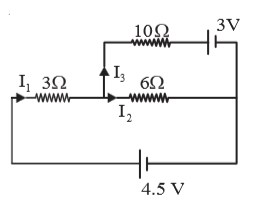Let and represent the emitter current, the collector current and the base current respectively in a transistor.then
(i) is slightly smaller than
(ii) is slightly greater than
(iii) is much smaller than
(iv) is much greater than
To solve the question regarding the relationships between the emitter current IE, collector current IC, and base current IB in a transistor, we will analyze the statements provided.
1. Understanding the Current Relationships:
- In a transistor, the emitter current IE is the sum of the collector current IC and the base current IB.
- This relationship can be expressed as:
IE=IC+IB
2. Analyzing the Base Current IB:
- The base current IB is typically much smaller than the emitter current IE because the transistor is designed to amplify current.
- Thus, we can conclude:
IB≪IE
3. Determining the Collector Current IC:
- Since IE is the sum of IC and IB, and knowing that IB is small, it follows that IC must be slightly less than IE:
IC≈IE−IB(where IB is small)
- Therefore, we can say:
IC<IE
4. Evaluating the Statements:
- (i) IC is slightly smaller than IE - True (as derived above).
- (ii) IC is slightly greater than IE - False (this contradicts our findings).
- (iii) IB is much smaller than IE - True (as established).
- (iv) IB is much greater than IE - False (this contradicts our findings).
5. Conclusion:
- The correct statements are:
- (i) IC is slightly smaller than IE
- (iii) IB is much smaller than IE
Final Answer:
The correct options are (i) and (iii).
- In a transistor, the emitter current IE is the sum of the collector current IC and the base current IB.
- This relationship can be expressed as:
IE=IC+IB
- The base current IB is typically much smaller than the emitter current IE because the transistor is designed to amplify current.
- Thus, we can conclude:
IB≪IE
- Since IE is the sum of IC and IB, and knowing that IB is small, it follows that IC must be slightly less than IE:
IC≈IE−IB(where IB is small)
- Therefore, we can say:
IC<IE
- (i) IC is slightly smaller than IE - True (as derived above).
- (ii) IC is slightly greater than IE - False (this contradicts our findings).
- (iii) IB is much smaller than IE - True (as established).
- (iv) IB is much greater than IE - False (this contradicts our findings).
- The correct statements are:
- (i) IC is slightly smaller than IE
- (iii) IB is much smaller than IE
The correct options are (i) and (iii).
Topper's Solved these Questions
- SEMICONDUCTORSBOOK - RESONANCE ENGLISHCHAPTER - SEMICONDUCTORSEXERCISE - Exercise
100 Videos
- SEMICONDUCTORSBOOK - RESONANCE ENGLISHCHAPTER - SEMICONDUCTORSEXERCISE - Exercise 2
16 Videos
- REVISION DPPBOOK - RESONANCE ENGLISHCHAPTER - REVISION DPPEXERCISE - All Questions
463 Videos
- SIMPLE HARMONIC MOTION BOOK - RESONANCE ENGLISHCHAPTER - SIMPLE HARMONIC MOTION EXERCISE - Advanced Level Problems
13 Videos
Similar Questions
Knowledge Check
In the circuit shown, the value of currents I1,I2andI3 are
 A3A,−3A2A,92AB92A,−32AC5A,4A,−3AD7A,54A,92A
A3A,−3A2A,92AB92A,−32AC5A,4A,−3AD7A,54A,92A
Calculate the collector and emitter current for which Ib=20mA,β=100
View SolutionIn a common base transistor circuit, IC is the Output current and IE is the input current. The current gain α is
View SolutionIf α=0.98 and current through emitter ie=20mA, the value of β is
View SolutionIn an NPN transistor the collector current is 10mA. If 90% of electrons reach collector, the emitter current (iE) and base current (iB) are given by
View SolutionIn common - emitter configuration of a transistor, the base current IE=2μA,α=0.9 then the value of IC is
View SolutionFind the current I1, I2, & I3, in the circuit.

View SolutionIn a transistor, doping level in base is increased slightly. How will it affect (i) collector current and (ii)base current?
View Solution

